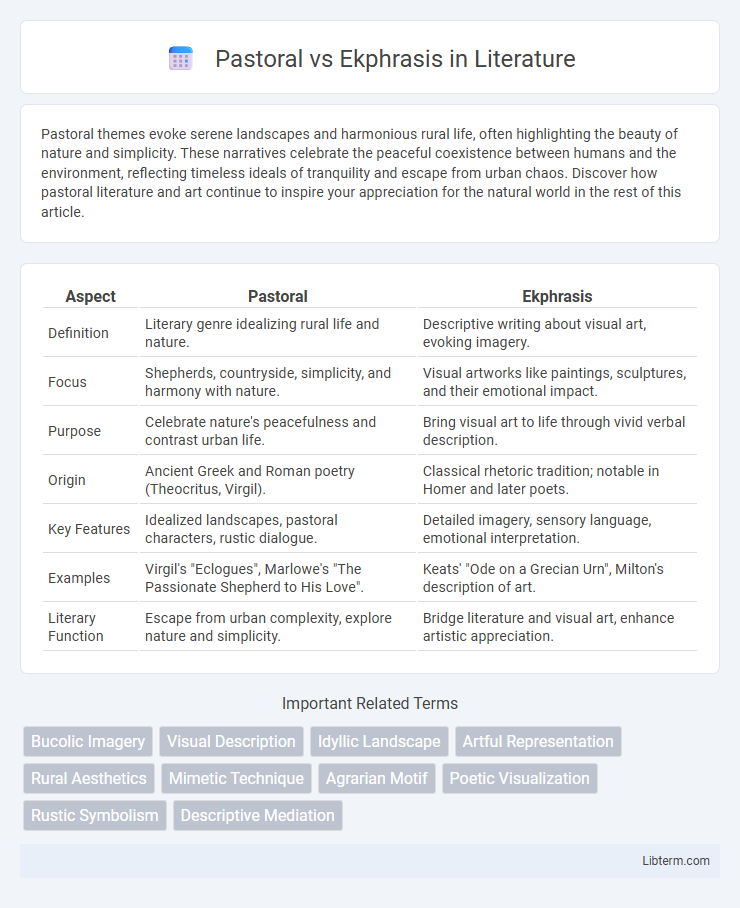Pastoral themes evoke serene landscapes and harmonious rural life, often highlighting the beauty of nature and simplicity. These narratives celebrate the peaceful coexistence between humans and the environment, reflecting timeless ideals of tranquility and escape from urban chaos. Discover how pastoral literature and art continue to inspire your appreciation for the natural world in the rest of this article.
Table of Comparison
| Aspect | Pastoral | Ekphrasis |
|---|---|---|
| Definition | Literary genre idealizing rural life and nature. | Descriptive writing about visual art, evoking imagery. |
| Focus | Shepherds, countryside, simplicity, and harmony with nature. | Visual artworks like paintings, sculptures, and their emotional impact. |
| Purpose | Celebrate nature's peacefulness and contrast urban life. | Bring visual art to life through vivid verbal description. |
| Origin | Ancient Greek and Roman poetry (Theocritus, Virgil). | Classical rhetoric tradition; notable in Homer and later poets. |
| Key Features | Idealized landscapes, pastoral characters, rustic dialogue. | Detailed imagery, sensory language, emotional interpretation. |
| Examples | Virgil's "Eclogues", Marlowe's "The Passionate Shepherd to His Love". | Keats' "Ode on a Grecian Urn", Milton's description of art. |
| Literary Function | Escape from urban complexity, explore nature and simplicity. | Bridge literature and visual art, enhance artistic appreciation. |
Understanding Pastoral and Ekphrasis
Pastoral poetry idealizes rural life, emphasizing nature, simplicity, and harmony between humans and the countryside, often portraying shepherds as central figures. Ekphrasis is a literary device that vividly describes or responds to a work of art, creating a bridge between visual imagery and verbal expression. Understanding pastoral involves recognizing its thematic focus on bucolic settings and escapism, while ekphrasis centers on translating visual art into rich, descriptive language.
Origins and Historical Context
Pastoral poetry originated in ancient Greece, notably with Theocritus in the 3rd century BCE, emphasizing rustic life and idealized rural landscapes as a critique of urban society. Ekphrasis, rooted in classical rhetoric and notably developed through works like Homer's detailed descriptions, evolved as a literary device that vividly portrays visual art or scenes to evoke sensory experience. Both forms reflect ancient cultural values: pastoral as a nostalgic escape and ekphrasis as a bridge between visual and verbal artistry, shaping literary traditions through the Hellenistic and Roman periods.
Core Themes and Motifs
Pastoral poetry centers on idealized rural life, emphasizing themes of nature's harmony, simplicity, and the contrast between pastoral innocence and urban corruption. Ekphrasis revolves around vivid, detailed descriptions of visual art, often exploring themes of representation, perception, and the interplay between visual and verbal mediums. While pastoral motifs include shepherds, rustic landscapes, and seasonal cycles, ekphrastic works use imagery to probe the relationship between reality and artistic interpretation.
Pastoral: Depicting Nature and Rural Life
Pastoral poetry centers on idealizing rural life and nature, often portraying shepherds, idyllic landscapes, and harmonious living away from urban complexities. It emphasizes simplicity, tranquility, and the natural world's cyclical patterns, reflecting humanity's connection to the environment. This genre contrasts with ekphrasis, which vividly describes artworks, focusing on visual representation rather than experiential life.
Ekphrasis: Bringing Art to Words
Ekphrasis transforms visual art into vivid literary descriptions, bridging the sensory gap between sight and language. This poetic technique captures the essence, emotion, and details of artworks, enabling readers to experience paintings, sculptures, or scenes through words. By translating imagery into narrative, ekphrasis deepens the appreciation of art and enriches literary expression.
Literary Techniques: Comparison and Contrast
Pastoral poetry employs bucolic imagery, simple diction, and idealized rural settings to evoke tranquility and nostalgia, while ekphrasis utilizes vivid, detailed descriptions to bring visual artworks to life through language, enhancing sensory experience. Pastoral often relies on dialogue and narrative to create a serene atmosphere, whereas ekphrasis focuses on metaphor, simile, and rich visual symbolism to interpret and expand the meaning of the depicted scene. Both techniques emphasize imagery, but pastoral evokes emotional resonance through nature and simplicity, contrasting with ekphrasis's concentrated, descriptive intensity centered on art representation.
Notable Works and Examples
Notable works in pastoral literature include Virgil's "Eclogues" and Edmund Spenser's "The Shepheardes Calender," which idealize rural life through romanticized shepherd characters. Ekphrasis is exemplified in John Keats' "Ode on a Grecian Urn" and W.H. Auden's "Musee des Beaux Arts," where vivid verbal descriptions bring visual art to life in poetic form. These distinct literary approaches utilize either bucolic settings or artistic representation to evoke emotional and aesthetic experiences.
Influence on Modern Literature
Pastoral themes, rooted in idealized rural life, heavily influenced modern literature by inspiring a nostalgic return to nature and simplicity in works by authors like Thomas Hardy and Robert Frost. Ekphrasis, the vivid description of art within text, shaped modern narrative techniques, enhancing visual imagery and deepening reader engagement through detailed portrayals found in poems by W.H. Auden and prose by Susan Sontag. Together, pastoral and ekphrasis enriched literary expression by merging natural imagery with artistic representation, fostering a multidimensional exploration of human experience.
Critical Perspectives and Debates
Pastoral poetry, traditionally idealizing rural life, faces critical scrutiny for its often simplistic nostalgia and potential to obscure socio-political complexities, while ekphrasis engages with visual art through vivid descriptive writing, raising debates on the relationship between textual and visual representation. Critics argue pastoral's romanticization contrasts with ekphrasis's challenge to language's capacity to fully capture material art, highlighting tensions between realism and artistic interpretation in literary studies. Contemporary scholarship explores how both forms negotiate meaning, authenticity, and the interaction of text and image within cultural and aesthetic frameworks.
Conclusion: Intersections and Divergences
Pastoral and ekphrasis intersect in their vivid depiction of sensory experience, with pastoral emphasizing idealized natural landscapes and ekphrasis focusing on detailed, often visual, descriptions of artworks or scenes. Divergences arise as pastoral conveys thematic elements of rural simplicity and harmonious existence, while ekphrasis serves primarily as a literary device to evoke imagery and stimulate the reader's imagination. Understanding these distinctions enhances appreciation of how each mode enriches narrative and poetic expression through unique yet overlapping techniques.
Pastoral Infographic

 libterm.com
libterm.com